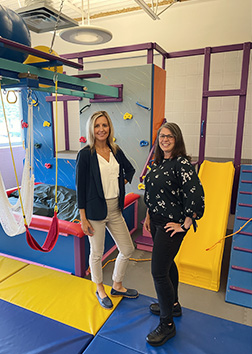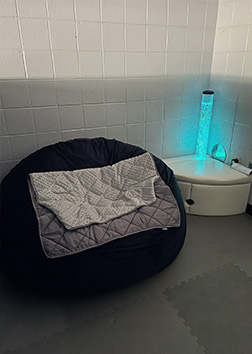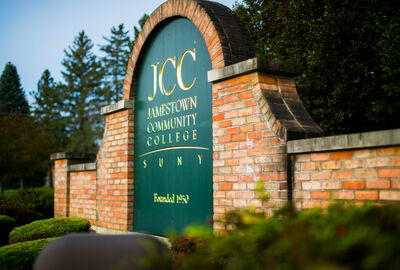A child’s most important “occupation” is play, says Sarah Tranum, director of the Occupational Therapy Assistant Program at SUNY Jamestown Community College. “It’s necessary for both the body and brain’s growth and organization.”

and Michelle Godfrey.
For children who have been affected by maternal substance use, play can be used to bridge deficits in neurological development. This is an area of focus for JCC’s OTA department, which has found a way to provide a valuable service to the area, and practical field experiences for students that begin as soon as their second semester in the program.
Through a grant from the Appalachian Regional Commission, Tranum and Michelle Godfrey, project coordinator and 2015 JCC graduate, are working to open a pediatric sensory clinic beginning this fall semester in the Sheldon Center on the Jamestown Campus. The clinic will make hands-on field experiences available for JCC students enrolled in the OTA program, by providing pro-bono sensory, emotional, and behavioral regulation therapies for young children.
In a recent commentary published in the Observer, Lillian Vitanza Ney and Christine Schuyler shared “the devastating impact on our children” the opioid epidemic creates. From immediate, significant illness at birth to longer-term impacts on the brain and nervous system, the rate of newborns affected by maternal substance use is five times higher in Chautauqua County than the state average.
“There’s a big need in Chautauqua County to support children whose mothers used drugs during pregnancy,” Tranum said. “OT can help kids and families manage these challenges, but insurance may not be willing to pay for the services. This free clinic is a safety net for those kids who we know need the service but can’t get it elsewhere.”
Newborns impacted by maternal substance use grow into young children who may struggle with behavioral issues, fine and gross motor deficits, and difficulties with postural control. These symptoms are viewed as sensory regulation issues, for which early intervention therapies are vital, and more effective if provided during infancy and preschool years when a child’s brain is most adaptable. Children who go without treatment find transitioning to school difficult and often require some type of special education services.
The rising need for special education services in Chautauqua County has increased fiscal demands on all of its systems. Awareness of the situation inspired the development of Strong Starts Chautauqua — a community-driven coalition of school providers; government, medical, and philanthropic foundations who work to educate families while providing screenings and referrals for needed services to help young children thrive.

“We have been involved since the beginning of this collaboration,” Tranum said. “Dr. Ira Chasnoff, who’s a leading researcher in the field of child development and prenatal substance exposure, with a focus on community approaches to helping children and families; has been an advisor of the Strong Starts Chautauqua initiative from its inception. He sees the value of OT as an integral service for these kids and families, so for the last few years we’ve been trying to figure out how we could make that happen.”
JCC student participation began last year when they learned of the need for services in the area and were challenged by Godfrey to create vision boards for the clinic and “OT a chair.” One of the pieces that will be utilized in the clinic was developed by students. It features tennis balls cut in half and glued to the back and seat of a chair to provide sensory stimulation that often helps children stay focused on other tasks.
“Part of the OTA curriculum is level one and level two fieldwork experience,” Tranum explained. “All of the students will cycle through the clinic for their level one experience. We’ll only be able to have one or two students completing their level two rotations because those are eight-week placements of full-time fieldwork.”
Godfrey says the clinic offerings and availability may vary from year-to-year, depending on how many students are enrolled in the program. Another mission of the clinic is to provide knowledge to parents of children who are struggling with sensory issues.
“We want parents to have tools to work with their children at home, so there’s that child and parent collaboration and connection,” Godfrey said. “One student will work with the parent and one will work with the child over the course of 11 weeks.”
Parents will be asked for permission to record sessions for use as part of JCC’s OTA curriculum. The recordings will be archived to create a bank of video resources to help students observe a variety of scenarios and enhance their practical knowledge.
The clinic is the first of its kind at JCC and as such, it will start small. In its first semester open, it is anticipated the clinic will see only five children, who will be referred by Strong Starts Chautauqua. Those children will have a full-service experience.
“We have to get our feet wet and see how it goes,” Tranum said. “Hopefully there will be other opportunities down the road for grants, because we know there are more than five kids who would benefit from this clinic.”
The clinic itself is comprised of a sensory gym with a pit that kids can drop into with a zip line, monkey bars, trampolines, a tunnel system and space for imaginary play. A “calming corner” includes an oversized bean-bag chair with color-changing lamp and noise-canceling magnetic walls that can be repositioned to suit the needs of each child using the space.
“I think every child deserves an opportunity to be as successful as they can,” Tranum said. “If we can help them manage behaviors that to this point have been out of their control, and not of their own creation, we can help them be as successful as possible, and that just helps our community and our schools.”
Tranum’s eyes are on the future. As JCC aims to enhance the workforce in the area, she contends the process must start during life’s earliest stages.
For more information on the OTA program at JCC, visit sunyjcc.edu/OTA.

